Dell DCRM, 9000, KYX1Y User Manual
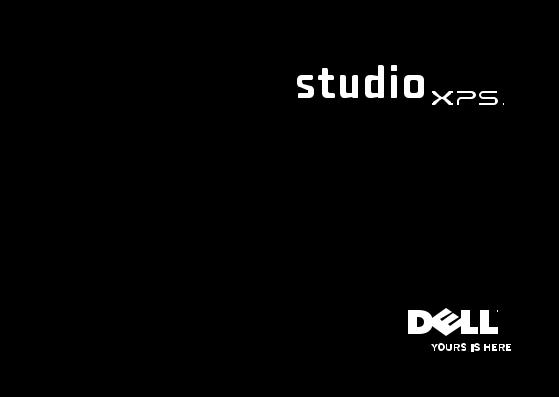
SETUP GUIDE


SETUP GUIDE
Model DCRM

Notes, Cautions, and Warnings
 NOTE: A NOTE indicates important information that helps you make better use of your computer.
NOTE: A NOTE indicates important information that helps you make better use of your computer.
CAUTION: A CAUTION indicates either potential damage to hardware or loss of data and tells you how to avoid the problem.
 WARNING: A WARNING indicates a potential for property damage, personal injury, or death.
WARNING: A WARNING indicates a potential for property damage, personal injury, or death.
If you purchased a Dell™ n Series computer, any references in this document to Microsoft® Windows® operating systems are not applicable.
__________________
Information in this document is subject to change without notice. © 2009 Dell Inc. All rights reserved.
Reproduction of these materials in any manner whatsoever without the written permission of Dell Inc. is strictly forbidden.
Trademarks used in this text: Dell, the DELL logo, YOURS IS HERE, Studio XPS, Dell On Call, and DellConnect are trademarks of Dell Inc.; Intel is a registered trademark and Core is a trademark of Intel Corporation in the U.S. and other countries; Microsoft, Windows, Windows Vista, and Windows Vista start button logo are either trademarks or registered trademarks of Microsoft Corporation in the United States and/or other countries; Blu-ray Disc is a trademark of the Blu ray Disc Association; Bluetooth is a registered trademark owned by Bluetooth SIG, Inc. and is used by Dell under license.
Other trademarks and trade names may be used in this document to refer to either the entities claiming the marks and names or their products. Dell Inc. disclaims any proprietary interest in trademarks and trade names other than its own.
July 2009 P/N KYX1Y Rev. A00
Contents
Setting Up Your Studio XPS Desktop 5
Before Setting Up Your Computer |
7 |
Connect the Display |
8 |
Connect the Keyboard and Mouse |
10 |
Connect the Network Cable (Optional) |
11 |
Connect the Power Cable |
12 |
Press the Power Button |
13 |
Set Up Microsoft Windows Vista |
13 |
Connect to the Internet (Optional) |
14 |
Using Your Studio XPS Desktop 16
Front View Features 16 Back View Features 19 Back Panel Connectors 20 Software Features 22 Dell Dock 25
Solving Problems 26
Beep Codes 26 Network Problems 27 Power Problems 28 Memory Problems 30 Lockups and Software Problems 31
Using Support Tools 33
Dell Support Center 33 System Messages 34 Hardware Troubleshooter 36 Dell Diagnostics 36
Restoring Your Operating System 40
System Restore 40 Dell Factory Image Restore 42 Operating System Reinstallation 44
3
Contents
Getting Help 46
Technical Support and Customer
Service 47 DellConnect™ 47 Online Services 48 Automated Order-Status Service 49 Product Information 49 Before You Call 52 Contacting Dell 53
4
Finding More Information and
Resources 54 Specifications 56 Appendix 61
Macrovision Product Notice 61
Index 62

Setting Up Your Studio XPS Desktop
This section provides information about setting up your Studio XPS™ 435T/9000 and connecting peripherals.
WARNING: Before you begin any of the procedures in this section, read the safety information that shipped with your computer. For additional safety best practices information, see the Regulatory Compliance Homepage at www.dell.com/regulatory_compliance.
5
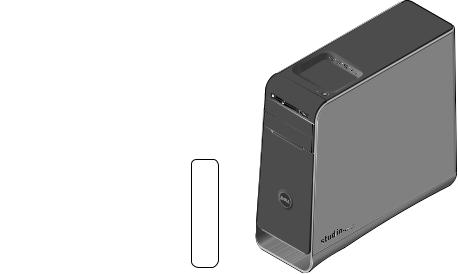
Setting Up Your Studio XPS Desktop
 NOTE: Your computer’s Service Tag is located on a label under the FlexBay panel on the front of your computer. Use this code to identify your computer when you access the Dell Support website or contact technical support.
NOTE: Your computer’s Service Tag is located on a label under the FlexBay panel on the front of your computer. Use this code to identify your computer when you access the Dell Support website or contact technical support.
WWCOM.DELLW
ServiceXXXX
XX–XXX–XXX Code: Service Express
6
Setting Up Your Studio XPS Desktop
Before Setting Up Your Computer
When positioning your computer, ensure that you allow easy access to a power source, adequate ventilation, and a level surface to place your computer.
Restricting airflow around your computer may cause it to overheat. To prevent overheating ensure that you leave at least 10.2 cm (4 inches) at the back of the computer and a minimum of 5.1 cm
(2 inches) on all other sides. You should never place your computer in an enclosed space, such as a cabinet or drawer when it is powered on.
7

Setting Up Your Studio XPS Desktop
Connect the Display
Your computer does not have an integrated video connector. You must use the connector available on the video card in the expansion slot to connect to the display.
Connect the Video Cable to the Display
Check your TV or monitor to see which type of connectors are available. Refer to the following table when identifying the connectors on your display to select the connection type you
will use.
VGA
HDMI
DVI
DisplayPort
8
Connect the display using either the VGA connector, the DVI connector, the HDMI connector, or the DisplayPort connector.
The HDMI connector is a high-performance digital connector that carries both video and audio signals for displays such as TVs and monitors with integrated speakers. The VGA connector carries only video signals for displays such as monitors and projectors.
Connect Using the VGA Connector
Connect the display using a VGA cable (which usually has blue connectors at both ends).
If your computer has a DVI connector, use the VGA cable (with blue connectors at both ends) with a DVI-to-VGA adapter (white connector).
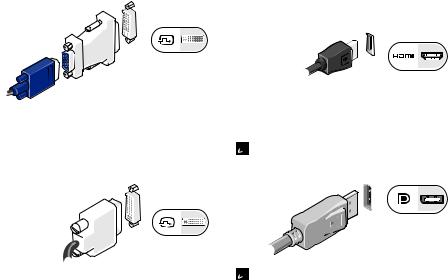
You can purchase a DVI-to-VGA adapter from the Dell website at www.dell.com.
Connect Using the DVI Connector
Connect the display using a DVI cable.
You can purchase additional HDMI and DVI cables from the Dell website at www.dell.com.
Setting Up Your Studio XPS Desktop
Connect Using the HDMI Connector
Connect the display using an HDMI cable.
Connect Using the DisplayPort Connector
Connect the display using a DisplayPort cable.
 NOTE: Do not connect devices to the DisplayPort connector and the HDMI connector at the same time.
NOTE: Do not connect devices to the DisplayPort connector and the HDMI connector at the same time.
 NOTE: For more information on connecting the display, see the documentation that shipped with your display.
NOTE: For more information on connecting the display, see the documentation that shipped with your display.
9
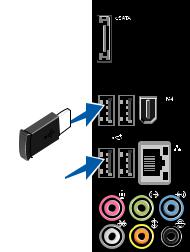
Setting Up Your Studio XPS Desktop
Connect the Keyboard and
Mouse
Connect the USB keyboard and mouse to the USB connectors on the back panel of your computer.
10

Setting Up Your Studio XPS Desktop
Connect the Network Cable
(Optional)
A network connection is not required to complete your computer setup, but if you have an existing network or Internet connection that uses a cable connection (such as a broadband device or Ethernet jack), you can connect it now.
 NOTE: Use only an Ethernet cable to connect to the network connector (RJ45 connector). Do not plug a telephone cable (RJ11 connector) into the network connector.
NOTE: Use only an Ethernet cable to connect to the network connector (RJ45 connector). Do not plug a telephone cable (RJ11 connector) into the network connector.
To connect your computer to a network or a broadband device, connect one end of the network cable to the network port or the broadband device. Connect the other end of the network cable to the network connector (RJ45 connector) on the back panel of your computer. A click indicates that the network cable has been securely attached.
11
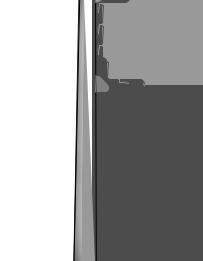
Setting Up Your Studio XPS Desktop
Connect the Power Cable
12

|
Setting Up Your Studio XPS Desktop |
Press the Power Button |
Set Up Microsoft Windows |
|
Vista |
To set up Windows Vista® for the first time follow the instructions on the screen. These steps are mandatory and may take some time to complete. The screens will take you through several procedures including accepting license agreements, setting preferences, and setting up an Internet connection.
CAUTION: Do not interrupt the operating system’s setup process. Doing so may render your computer unusable and you will need to reinstall the operating system.
 NOTE: It is recommended that you download and install the latest BIOS and drivers for your computer available on the Dell Support website at support.dell.com.
NOTE: It is recommended that you download and install the latest BIOS and drivers for your computer available on the Dell Support website at support.dell.com.
13

Setting Up Your Studio XPS Desktop
Connect to the Internet (Optional)
To connect to the Internet, you need an external modem or network connection, and an Internet Service Provider (ISP).
If an external USB modem or WLAN adapter is not a part of your original order, you can purchase one from the Dell website at www.dell.com.
Setting Up a Wired Connection
•If you are using a dial-up connection, connect the telephone line to the external USB modem (optional) and to the telephone wall connector before you set up your Internet connection.
•If you are using a DSL or cable/satellite modem connection, contact your ISP or cellular telephone service for setup instructions.
14
To complete setting up your wired Internet connection, follow the instructions in “Setting Up Your Internet Connection” on page 15.
Setting Up a Wireless Connection
 NOTE: To set up your wireless router, see the documentation that shipped with your router.
NOTE: To set up your wireless router, see the documentation that shipped with your router.
Before you can use your wireless Internet connection, you need to connect to your wireless router.
To set up your connection to a wireless router:
1.Save and close any open files, and exit any open programs.
2.Click Start  → Connect To.
→ Connect To.
3.Follow the instructions on the screen to complete the setup.

Setting Up Your Internet Connection
ISPs and ISP offerings vary by country. Contact your ISP for offerings available in your country.
If you cannot connect to the Internet but have successfully connected in the past, the ISP might have a service outage. Contact your ISP to check the service status, or try connecting again later.
Have your ISP information ready. If you do not have an ISP, the Connect to the Internet wizard can help you get one.
 NOTE: The following instructions are applicable to the Windows default view, so they may not apply if you set your Dell™ computer to the Windows Classic view.
NOTE: The following instructions are applicable to the Windows default view, so they may not apply if you set your Dell™ computer to the Windows Classic view.
Setting Up Your Studio XPS Desktop
1.Save and close any open files, and exit any open programs.
2.Click Start  → Control Panel.
→ Control Panel.
3.Click Network and Internet→ Network and Sharing Center→ Setup a Connection→
Connect to the Internet.
The Connect to the Internet window appears.
 NOTE: If you do not know which type of connection to select, click Help me choose or contact your ISP.
NOTE: If you do not know which type of connection to select, click Help me choose or contact your ISP.
4.Follow the instructions on the screen and use the setup information provided by your ISP to complete the setup.
15
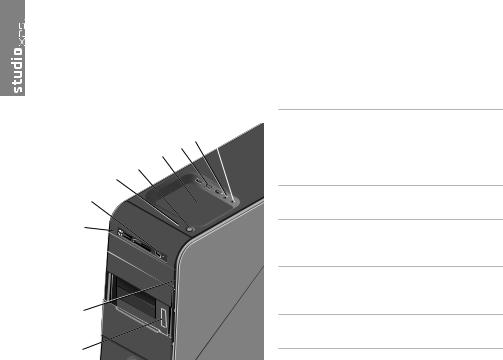
Using Your Studio XPS Desktop
This section provides information about the features available on your Studio XPS™ Desktop.
Front View Features
11 12 13 14
10
9 8
7
6 
5 
4 
3
2 
1
1Service Tag and Express Service Code (located on a label under the FlexBay panel) — Used to identify your computer when you access the Dell Support website or call technical support.
2FlexBay panel — Covers the FlexBay slots.
3Optical drive eject button — Press the marked portion on the lower end of the button to eject the disc.
4FlexBay slots (2) — Supports a floppy drive, a Media Card Reader, or an additional hard drive.
5Optical drive bay — Can contain an additional optical drive.
16

6Optical drive — Plays or records only standard-size (12 cm) CDs, DVDs, and Blu-ray Discs.
7Media Card Reader — Provides a fast and convenient way to view and share digital photos, music, and videos stored on a memory card.
8

 USB 2.0 connector — Connects to USB devices that are connected occasionally such as memory keys, digital cameras, and MP3 players.
USB 2.0 connector — Connects to USB devices that are connected occasionally such as memory keys, digital cameras, and MP3 players.
9

 Hard drive activity light — Turns on when the computer reads or writes data. A blinking blue light indicates hard drive activity.
Hard drive activity light — Turns on when the computer reads or writes data. A blinking blue light indicates hard drive activity.
CAUTION: To avoid loss of data, never turn off the computer while the hard drive activity light is blinking.
Using Your Studio XPS Desktop
10

 Power button and light — Turns the power on or off when pressed. The light in the center of this button indicates the power state:
Power button and light — Turns the power on or off when pressed. The light in the center of this button indicates the power state:
•Off — the computer is either turned off or is not receiving power.
•Blinking white — the computer is in sleep state.
•Solid white — the computer is on.
•Blinking amber — there may be a problem with the system board.
•Solid amber — there may be a problem with either the system board or power supply.
NOTE: For information on power problems, see “Power Problems” on page 28.
11Accessory tray — Used to place devices or secure cables to avoid clutter.
17

Using Your Studio XPS Desktop
12 USB 2.0 connectors (3) — Connects to USB devices that are connected occasionally such as memory keys, digital cameras, and MP3 players.
USB 2.0 connectors (3) — Connects to USB devices that are connected occasionally such as memory keys, digital cameras, and MP3 players.
13 Line-in or microphone connector —
Line-in or microphone connector —
Connects to a microphone for voice or to an audio cable for audio input.
14 Headphone connector — Connects to headphones.
Headphone connector — Connects to headphones.
NOTE: To connect to a powered speaker or sound system, use the audio out or S/PDIF connector on the back of your computer.
18

|
|
|
Using Your Studio XPS Desktop |
Back View Features |
|
1 |
Security cable slot — Connects to a lock |
|
|
|
for a security cable used as an anti-theft |
|
|
|
device. |
5 |
|
|
NOTE: Before you buy a lock, ensure that it |
|
|
works with the security cable slot on your |
|
4 |
|
|
|
|
|
computer. |
|
|
|
2 |
Expansion card slots — Provides access |
|
|
|
to connectors for any installed PCI and PCI |
|
|
|
express cards. |
3 |
|
3 |
Back panel connectors — Plug USB, |
|
|
audio, and other devices into the |
|
|
|
|
|
|
1 |
|
appropriate connector. |
|
4 |
Power connector — Connects to |
|
|
|
||
|
|
|
the power cable. Appearance of this |
|
|
|
connector may vary. |
2 |
|
5 |
Power supply light — Indicates power |
|
|
availability of the power supply. |
|
|
|
|
19
